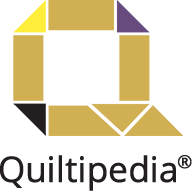Stenciling
A Stencil is a thin sheet of plastic, or 90 to 110 lb paper (like a manila folder), that has a design cut out from it. Stenciling is the act of painting using a stencil, where the stencil is open, the fabric (wood or other surface) will have the design painted when the stencil is removed. For repetitive designs registration marks are used to ensure repeat designs will be aligned. Stenciling using inks or paints and allows you to create your own design consistantly multiple times. The Stencil brushes are generally made from natural bristles and come in sizes from 1/4" to 7/8' and are round. Originally the paint was done lightly in layers, working on the outside edges first and continuously building up the layers of paint. This technique ads depth to the design as the edges are darker than the inside of the design. Stencils were also used on walls as "wall paper".
You can make you own stencil or buy a comercially available stencil. Stenciling can be used to leave small lines for quilting designs or repetitive designs to add texture and dimension to a quilt.
Benefits of Stenciling
- Stenciling allows you to transfer a design repeatedly onto fabric.
- Stenciling allows you to use any desired colors or painting technique to add interest to the surface
- Making your own Stencil allows you to personalizee your project.
Tools and Supplies for Stenciling
You'll need these if you want to start Stenciling:
- Stencils
- Stencil plastic or other heavy paper to make a stencil with a sharp craft knife or exacto knife and a cutting surface
- Stencil brushes
- Paints or inks as appropriate for your project
What I Wish I Knew When I Started Stenciling
For STENCILING, there are a huge variety of commercial stencils available, but cutting your own design from plastic is also easy. If you want to make your own stencil, measure the area to be stenciled and determine if the design is continuous and how many repeats will be needed to cover the length of the space. If the design needs to be aligned, thin plastic is best so you can add registration marks with an indelible ink pen so the designs will be aligned. Be sure to pay attention to the inside edges of the design and clean the stencil so the paint does not bleed under the stencil.









